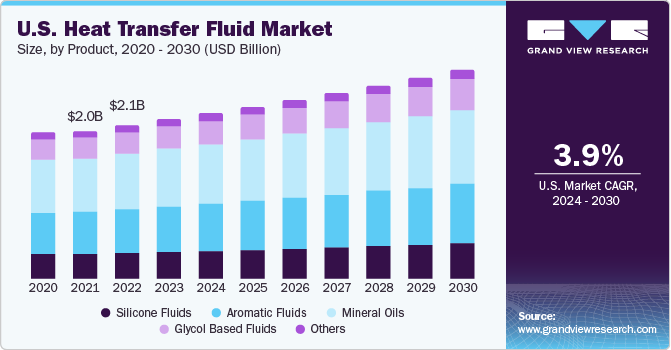The global heat transfer fluids market was valued at USD 11.06 billion in 2023 and is projected to grow at a compound annual growth rate (CAGR) of 3.7% from 2024 to 2030. One of the primary drivers of this market growth is the rapid global adoption of concentrated solar power (CSP), which significantly boosts the demand for heat transfer fluids (HTFs). These fluids are essential industrial products derived primarily from petroleum sources, and they play a key role in preventing overheating and storing thermal energy. The primary raw materials used in the production of HTFs include crude oil, silica, and base oils.
The core attributes of heat transfer fluids include low viscosity, a non-corrosive nature, high thermal conductivity and diffusivity, and the ability to operate under extreme phase transition temperatures. These characteristics make HTFs invaluable in a wide range of industrial applications. They are crucial in ensuring the efficient transfer of heat in various processes, particularly in energy generation and thermal storage systems.
The United States is a key player in the global CSP market, contributing significantly to the installed capacity for concentrated solar power. The U.S. strategically utilizes its CSP plants to deliver power outputs during periods of exceptionally high demand, making the role of heat transfer fluids even more critical. These fluids are integral to improving the efficiency of CSP plants by aiding in the collection of energy from the solar field and transporting it to energy storage systems. The stored thermal energy can be used to generate electricity even after sunset or during cloudy weather conditions, providing a significant advantage over other renewable energy sources, such as photovoltaic (PV) systems.
Gather more insights about the market drivers, restrains and growth of the Heat Transfer Fluids Market
Product Insights
The glycol-based heat transfer fluids segment is expected to be the fastest-growing product category, with a projected revenue CAGR of 4.1% over the forecast period. Glycol-based fluids are favored for their excellent antifreeze properties, which make them suitable for a wide range of applications. This segment is also seeing an increasing shift towards bio-based glycols, which are becoming an important component in HTF formulations due to their environmental benefits. Bio-based glycols are particularly attractive because they can be used in both high and low-temperature applications, offering versatility across a variety of industrial sectors.
Mineral oils, another common type of heat transfer fluid, are widely used in radiator heaters, which are essential in both commercial and residential applications. These oils are preferred for their high resistance to chemical oxidation and thermal cracking, making them durable under various operational conditions. They are also non-toxic and non-corrosive, which enhances their safety and usability. Furthermore, mineral oils provide high thermal conductivity and specific heat, allowing for efficient heat transfer. However, one limitation of mineral oils is their high degradation rate when exposed to extreme temperatures over long periods.
Another important class of HTFs is alkylated aromatic compounds, which are typically formulated for use in closed-loop heating systems based on the Rankine cycle. These HTFs are particularly suitable for high-temperature applications in industries such as asphalt production, gas processing, tank cleaning, and plastic manufacturing. Alkylated aromatic compounds are versatile, functioning efficiently in both the vapor phase and liquid phase. They are known for their excellent fluid and heat transfer properties, which make them ideal for processes involving relatively low temperatures while still maintaining stability and performance under challenging conditions.
Heat transfer fluids market is experiencing steady growth driven by the expanding use of concentrated solar power (CSP), increasing demand for energy storage solutions, and advancements in heat transfer fluid formulations. Glycol-based HTFs are emerging as the fastest-growing segment, while mineral oils and alkylated aromatic compounds continue to dominate key industrial sectors. As technologies evolve and the demand for renewable energy and efficient thermal management increases, the heat transfer fluids market is poised for continued expansion and innovation.
Order a free sample PDF of the Heat Transfer Fluids Market Intelligence Study, published by Grand View Research.


